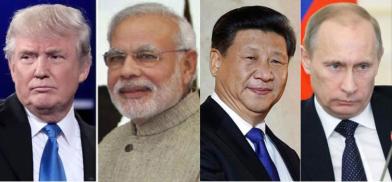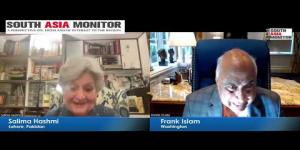Trump's Tariffs and India's Strategic Dilemma: Acid Test for Modi Government
For Modi, the political cost of appearing to bow to American pressure may be almost as high as the economic cost of resisting it. In the end, the tariffs are not just about commerce. They are a test of whether India can still straddle the fault lines of great-power rivalry—whether the world’s most populous democracy is being forced into the uncomfortable role of choosing sides.

India is staring down a crisis that could unravel years of export-led growth and shred millions of jobs. On August 27, U.S. President Donald Trump’s punitive tariff regime—already a 25 percent burden on Indian exports—is set to double.
The move threatens not only India’s traditional trade engines such as textiles, auto components, and jewelry, but also high-growth sectors like pharmaceuticals and electronics that had begun to anchor New Delhi’s aspirations of becoming a global manufacturing hub.
For businesses that operate on razor-thin margins, the shock is existential. In Gurugram, the beating heart of India’s automotive supply chain, hundreds of small and medium enterprises face the prospect of mass closures.
The gem and jewelry industry, which counts the United States as its single largest market, warns that nearly a third of its trade could be wiped out overnight, ceding space to rivals in Italy, Vietnam and Thailand.
The devastation does not stop there. The U.S. pharmaceutical market—where Indian generics have long supplied affordable drugs—has so far been exempt from tariffs. But Trump has promised a sweeping 150 percent levy, rising possibly to 250 percent.
Should that promise materialise, one of India’s few genuinely global industries would collapse under the weight of protectionism.
Electronics, too, hang in balance with the tariffs putting at risk all non-smartphone exports estimated to be worth $ 15 billion, including electric inverters, battery chargers, transformer parts, PCB assemblies and IT hardware.
Nationalist Flourish Masks Grim Reality
For Prime Minister Narendra Modi, the timing could not be worse. Only days ago, from the ramparts of the Red Fort on Independence Day, he urged Indians to embrace “self-reliance” as a shield against “selfish interests.”
The rhetoric evoked Mahatma Gandhi’s swadeshi call, but in practice India’s integration into global supply chains leaves little room for autarky.
Behind the nationalist flourish lies the grim reality that India risks losing access to its largest export market and economic powerhouse, the United States, at the very moment when growth is slowing and unemployment is rising.
Washington insists there is a way out. Peter Navarro, Trump’s chief trade adviser, writing in the Financial Times, accused India of serving as a “clearinghouse” for Russian oil—buying discounted barrels, refining them, and exporting the products at a profit.
Navarro argues that Indian purchases both undercut Western sanctions and fund Moscow’s war machine. His prescription: stop buying Russian crude.
In private, Indian officials acknowledge that Trump’s tariffs are as much about geopolitics as trade deficits.
Until recently, New Delhi sought to mollify Washington by increasing purchases of U.S. energy and defense equipment. But Trump’s escalation linked tariffs directly to India’s Russian oil imports.
Risk of Domestic Backlash
The irony is that India has already begun cutting back on Russian crude, wary of overdependence and sensitive to the shifting winds in Washington.
The problem is that Modi cannot publicly admit as much. Doing so would puncture his carefully crafted narrative of “strategic autonomy”—the claim that India can navigate the great-power rivalry without taking sides.
Acknowledging U.S. pressure would not only damage India’s global standing but also risk domestic backlash in a political culture that prizes foreign policy independence and standing up to foreign diktats.
Thus, New Delhi finds itself boxed in. Publicly, Modi rails against tariffs and extols self-reliance. Quietly, India trims Russian imports, hoping Washington will notice without demanding an explicit concession.
However, time is running out. Trump’s tariffs are scheduled to bite in days and the consequences could be catastrophic: a hollowed-out manufacturing sector, a crippled export machine, and mass unemployment.
Can the US be Trusted?
The bigger question is whether India can still count on the United States as a reliable economic partner.
The Bush, Obama and Biden years were marked by quiet indulgence of India’s balancing act, but Trump has made it clear - trade access comes with strings attached. If India wants the U.S. market, it must pay in geopolitical currency.
The forecast is stark. Even if India quietly phases down Russian crude, Trump’s tariff threats show that Washington has discovered a new lever: coercive economic statecraft.
Once weaponized, it will not be easily rolled back. India may buy temporary relief by conceding on oil, but the precedent is set—future access to the U.S. market will be conditioned on foreign policy alignment.
For Modi, the political cost of appearing to bow to American pressure may be almost as high as the economic cost of resisting it. In the end, the tariffs are not just about commerce. They are a test of whether India can still straddle the fault lines of great-power rivalry—whether the world’s most populous democracy is being forced into the discomfiting role of choosing sides.
(The author is a senior journalist and strategic analyst who specialises in the political economy. Views expressed are personal)
�� Mon objectif : aider les entrepreneurs
via leur site web à générer de la visibilité et à attirer des clients.
���� Ma recette d’accompagnement :
1. Des formations personnalisées (pour ceux qui veulent faire eux-mêmes)
2. Du coaching (pour ceux qui veulent être accompagnés sur
la durée)
3. De la prestation (pour ceux qui préfèrent
externaliser)
Mes prestations :
– Référencement Naturel
– Référencement Payant
– Marketing Digital
– Accompagnement Réseaux Sociaux
– Community management / gestion de blog
– Campagnes de Stratégie Digital
– Conférences (CCI, réseaux pros, pépinières d’entreprises,
Organismes de formation etc)
Audit Gratuit de votre site
Questions sur le référencement
Livre blanc Fiche Google My Business
Découvrez « La minute de Fred »
10 questions sur le référencement
Découvrez les secrets d’un référencement naturel infaillible en 5 étapes simples !
5 conseils pour optimiser le référencement SEO de mon site
Guide SEO pour débuter son référencement naturel
Votre consultant SEO sur TikTok
Votre consultant SEO sur Pinterest
Votre consultant SEO sur Twitter
Votre consultant SEO sur Youtube










Post a Comment